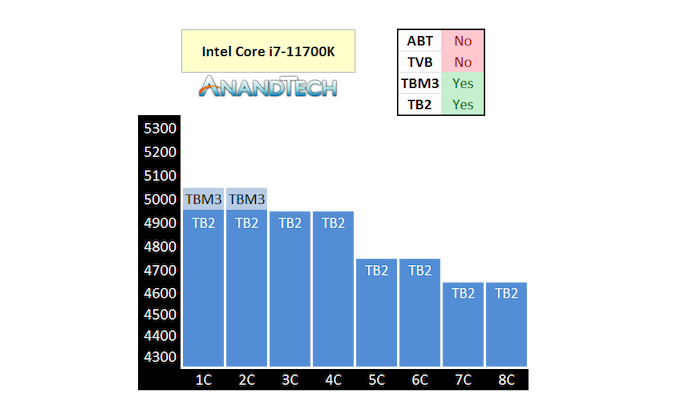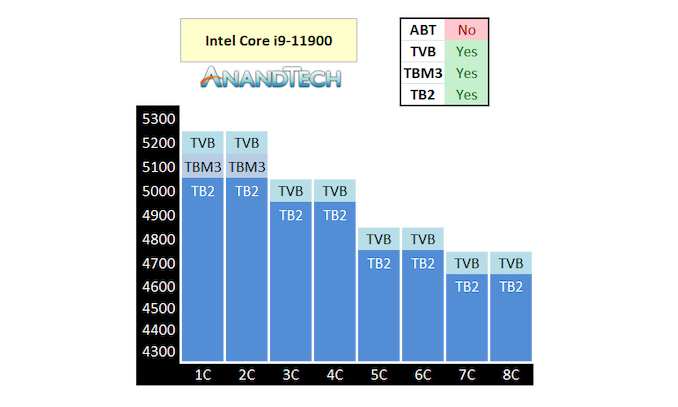Intel Rocket Lake (14nm) Review: Core i9-11900K, Core i7-11700K, and Core i5-11600K
by Dr. Ian Cutress on March 30, 2021 10:03 AM EST- Posted in
- CPUs
- Intel
- LGA1200
- 11th Gen
- Rocket Lake
- Z590
- B560
- Core i9-11900K
Intel’s New Adaptive Boost Technology for Core i9-K/KF
Taken from our news item
To say that Intel’s turbo levels are complicated to understand is somewhat of an understatement. Trying to teach the difference between the turbo levels to those new to measuring processor performance is an art form in of itself. But here’s our handy guide, taken from our article on the subject.
Adaptive Boost Technology is now the fifth frequency metric Intel uses on its high-end enthusiast grade processors, and another element in Intel’s ever complex ‘Turbo’ family of features. Here’s the list, in case we forget one:
| Intel Frequency Levels | ||
| Base Frequency | - | The frequency at which the processor is guaranteed to run under warranty conditions with a power consumption no higher than the TDP rating of the processor. |
| Turbo Boost 2.0 | TB2 | When in a turbo mode, this is the defined frequency the cores will run at. TB2 varies with how many cores are being used. |
| Turbo Boost Max 3.0 | TBM3 'Favored Core' |
When in a turbo mode, for the best cores on the processor (usually one or two), these will get extra frequency when they are the only cores in use. |
| Thermally Velocity Boost | TVB | When in a turbo mode, if the peak thermal temperature detected on the processor is below a given value (70ºC on desktops), then the whole processor will get a frequency boost of +100 MHz. This follows the TB2 frequency tables depending on core loading. |
| Adaptive Boost Technology | ABT 'floating turbo' |
When in a turbo mode, if 3 or more cores are active, the processor will attempt to provide the best frequency within the power budget, regardless of the TB2 frequency table. The limit of this frequency is given by TB2 in 2-core mode. ABT overrides TVB when 3 or more cores are active. |
| *Turbo mode is limited by the turbo power level (PL2) and timing (Tau) of the system. Intel offers recommended guidelines for this, but those guidelines can be overridden (and are routinely ignored) by motherboard manufacturers. Most gaming motherboards will implement an effective ‘infinite’ turbo mode. In this mode, the peak power observed will be the PL2 value. It is worth noting that the 70ºC requirement for TVB is also often ignored, and TVB will be applied whatever the temperature. | ||
Intel provided a slide trying to describe the new ABT, however the diagram is a bit of a mess and doesn’t explain it that well. Here’s the handy AnandTech version.
First up is the Core i7-11700K that AnandTech has already reviewed. This processor has TB2, TBM3, but not TVB or ABT.
The official specifications show that when one to four cores are loaded, when in turbo mode, it will boost to 4.9 GHz. If it is under two cores, the OS will shift the threads onto the favored cores and Turbo Boost Max 3.0 will kick in for 5.0 GHz. More than four core loading will be distributed as above.
On the Core i9-11900, the non-overclocking version, we also get Thermal Velocity Boost which adds another +100 MHz onto every core max turbo, but only if the processor is below 70ºC.
We can see here that the first two cores get both TBM3 (favored core) as well as TVB, which makes those two cores give a bigger jump. In this case, if all eight cores are loaded, the turbo is 4.6 GHz, unless the CPU is under 70ºC, then we get an all-core turbo of 4.7 GHz.
Now move up to the Core i9-11900K or Core i9-11900KF, which are the only two processors with the new floating turbo / Adaptive Boost Technology. Everything beyond two cores changes and TVB no longer applies.
Here we see what looks like a 5.1 GHz all-core turbo, from three cores to eight cores loaded. This is +300 MHz above TVB when all eight cores are loaded. But the reason why I’m calling this a floating turbo is because it is opportunistic.
What this means is that, if all 8 cores are loaded, TB2 means that it will run at 4.7 GHz. If there is power budget and thermal budget, it will attempt 4.8 GHz. If there is more power budget and thermal budget available, it will go to 4.9 GHz, then 5.0 GHz, then 5.1 GHz. The frequency will float as long as it has enough of those budgets to play with, and it will increase/decrease as necessary. This is important as different instructions cause different amounts of power draw and such.
If this sounds familiar, you are not wrong. AMD does the same thing, and they call it Precision Boost 2, and it was introduced in April 2018 with Zen+. AMD applies its floating turbo to all of its processors – Intel is currently limiting floating turbo to only the Core i9-K and Core i9-KF in Core 11th Gen Rocket Lake.
One of the things that we noticed with AMD however is that this floating turbo does increase power draw, especially with AVX/AVX2 workloads. Intel is likely going to see similar increases in power draw. What might be a small saving grace here is that Intel’s frequency jumps are still limited to full 100 MHz steps, whereas AMD can do it on the 25 MHz boundary. This means that Intel has to manage larger steps, and will likely only cross that boundary if it knows it can be maintained for a fixed amount of time. It will be interesting to see if Intel gives the user the ability to change those entry/exit points for Adaptive Boost Technology.
There will be some users who are already familiar with Multi-Core Enhancement / Multi-Core Turbo. This is a feature from some motherboard vendors have, and often enable at default, which lets a processor reach an all-core turbo equal to the single core turbo. That is somewhat similar to ABT, but that was more of a fixed frequency, whereas ABT is a floating turbo design. That being said, some motherboard vendors might still have Multi-Core Enhancement as part of their design anyway, bypassing ABT.
Overall, it’s a performance plus. It makes sense for the users that can also manage the thermals. AMD caught a wind with the feature when it moved to TSMC’s 7nm. I have a feeling that Intel will have to shift to a new manufacturing node to get the best out of ABT, and then we might see the feature on the more mainstream CPUs, as well as becoming default as standard.













279 Comments
View All Comments
GeoffreyA - Tuesday, March 30, 2021 - link
It could be due to x264 limiting the number of threads because when vertical resolution divided by threads drops below a certain threshold---I think round about 30 or 40---quality begins to suffer.GeoffreyA - Wednesday, March 31, 2021 - link
I tested this now on FFmpeg but it should be the same on Handbrake because the x264/5 libraries are doing the actual encoding.I only have a 4C/4T CPU but used the "-threads" switch to request more. On x264, regardless of resolution, once more than 16 threads are asked for, it logs a warning that it's not recommended but goes ahead and uses the requested count, up to 128. I assume that running at default settings, like AT is probably doing with Handbrake, will let x264 cut off at 16 by itself. If someone could confirm this with a 32-thread CPU, that would be nice. As for x265, I gave it a try as well and the encoder refuses to go on if more than 16 threads are requested, saying the range must be between 0 and X265_MAX_FRAME_THREADS.
In short, I reckon both these codecs are cutting off at 16 threads on default settings. If Ian or someone else could test how much extra is gained by manually putting in the count on a 32T CPU, that would be interesting.
scott_htpc - Tuesday, March 30, 2021 - link
Splat. Backporting doesn't really work & dead-end platform.What I'd really like to read is a detailed narrative of Intel's blunders over the last 5-10 years. To me, it probably makes a case study in failed leadership & hubris, but I would really like to read an authoritative, detailed account. I'm curious why the risks of their decisions were not enough to dissuade them to take a better path forward.
Prosthetic Head - Tuesday, March 30, 2021 - link
Yes, some sort of post mortem on Intel development over the last few years would be interesting. Once they abandoned the Pentium 4 madness, they did a good job with Core, Core2 and then the early stages of the 'i' series. Because AMD were by that point down their own dead end, they had essentially no competition for about a decade. The tempting easy explanation is that as a de facto monopoly for desktop and laptop CPUs, they only innovated enough to keep the upgrade cycle ticking over, then when AMD made a rapid comeback they got caught with their pants down and some genuine technical difficulties in fab tech.... But the reality could be a lot more complex and interesting than that.Hifihedgehog - Tuesday, March 30, 2021 - link
> But the reality could be a lot more complex and interesting than that.The reality is Conroe was a once-in-a-lifetime IPC improvement, literally 90% better (or nearly double the performance!) clock-for-clock than the ill-fated Pentium 4 (see here: https://www.reddit.com/r/intel/comments/m7ocxj/pen... They are not going to get that again unless Gelsinger clones himself across Intel's entire leadership team. Now, they may get something Zen-like in the ~50% range, but nothing Conroe-like unless ALL the stars align after a decade of complacency.
Hifihedgehog - Tuesday, March 30, 2021 - link
https://www.reddit.com/r/intel/comments/m7ocxj/pen...29a - Tuesday, March 30, 2021 - link
Keep in mind that P4 was a piece of shit built for marketing high clock speeds and was easily beaten by Athlon 64 running 1Ghz slower so getting that much IPC wasn't as hard as usual.GeoffreyA - Wednesday, March 31, 2021 - link
"Keep in mind that P4 was a piece of"Not to defend the P4, but Northwood wasn't half bad in the Athlon XP's time, beating it quite a lot. It was Prescott that mucked it all up.
TheinsanegamerN - Wednesday, March 31, 2021 - link
TBF, the only reason it wasnt half bad is AMD's willingness to just abandon XP. I mean, only 2.23 GHz? 3 GHz OCs were not hard to do with their mobile lineup, and those obliterated anything intel would have until conroe. IF they had released 2.4, 2.6, and 2.8 GHz athlon XPs intel would have been losing every benchmark against them.GeoffreyA - Friday, April 2, 2021 - link
Oh yes, the XP had the higher IPC and would have given Intel a sound drubbing if its clocks were only higher. Thankfully, the Athlon 64 came and turned the tables round. I remember in those days my heart was set on the 3200+ Barton but I ended up with a K8 budget system of sorts.